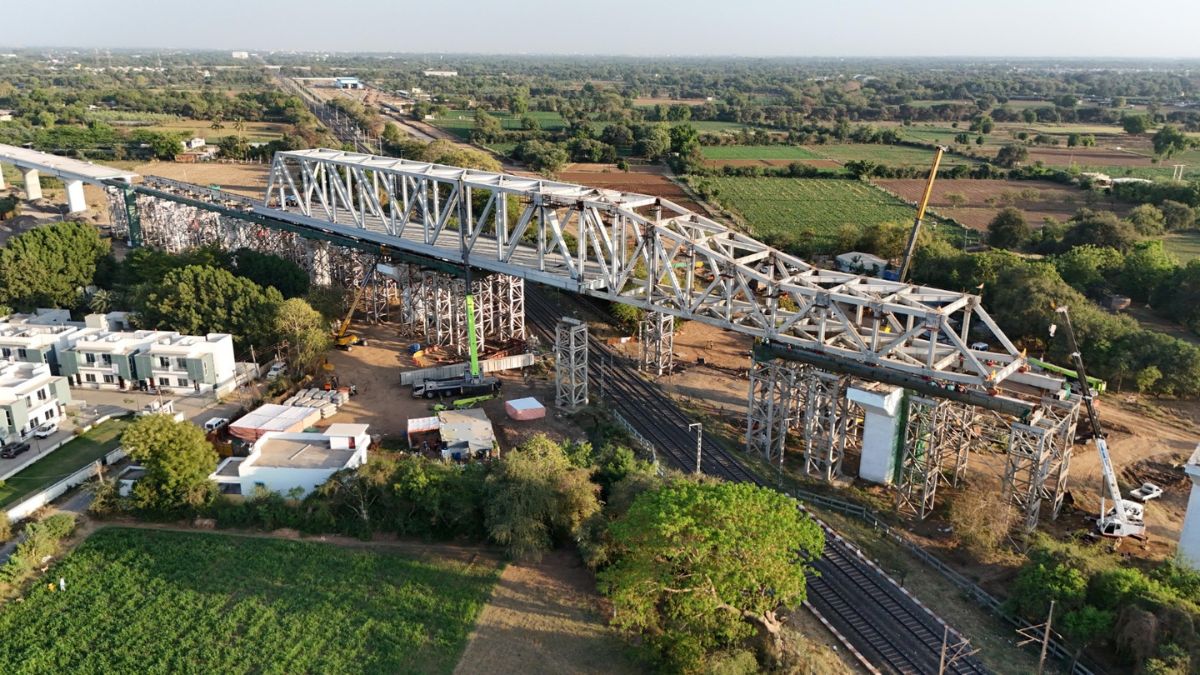Bullet Train Project Takes a Big Stride with Launch of First 100-meter Steel Bridge in Gujarat
The successful launch of this first 100-meter steel bridge signifies a major leap forward in the construction of the Mumbai-Ahmedabad Bullet Train Corridor

Advertisement
Ahmedabad : A significant milestone has been reached in the development of the much-anticipated Mumbai-Ahmedabad Bullet Train Corridor with the launch of the first 100-meter steel bridge near Nadiad in Gujarat. This impressive feat showcases India’s growing prowess in infrastructure construction, leveraging both domestic capabilities and Japanese expertise under the “Make in India” initiative.
The 1486-metric ton steel bridge was meticulously fabricated at a workshop in Bhuj, Gujarat, approximately 310 kilometers from the launch site. To ensure structural integrity, each batch of steel underwent rigorous testing procedures using Ultrasonic Testing (UT) at the manufacturer’s facilities.
The bridge assembly process involved meticulous planning and execution. The main bridge structure was assembled on temporary supports 15.5 meters above the ground. Following this, a 63-meter long launching nose weighing approximately 430 metric tons was integrated with the bridge. Utilizing a sophisticated system of automatic jacks and high-tension strands, engineers successfully pulled the bridge into its final position during a meticulously planned traffic and power block on the Vadodara-Ahmedabad railway line.
Several noteworthy technical aspects contribute to the bridge’s strength and durability. The fabrication process involved high-precision cutting, drilling, welding, and painting, adhering to stringent Japanese design specifications. Certified international welding experts closely monitored the welding process, ensuring the highest quality standards.
The bridge boasts a first-of-its-kind painting technique in India, adhering to the C-5 Painting System outlined by the Japan Road Association. Furthermore, the joints between steel members utilize Tor Shear Type High Strength Bolts (TTHSB), another pioneering application in Indian railway projects.
This launch marks the second of 28 steel bridges planned for the Mumbai-Ahmedabad Bullet Train Corridor. The first bridge was successfully installed over National Highway 53 in Surat. These bridges offer a significant advantage over conventional pre-stressed concrete bridges, as their span can range from 60 meters (simply supported) to a remarkable 130 meters + 100 meters (continuous span).
Steel bridges are particularly well-suited for high-speed applications due to their superior strength-to-weight ratio. While pre-stressed concrete bridges typically function well for most sections, including river crossings, they are limited in their span. India’s existing expertise in fabricating steel bridges for heavy haul and semi-high-speed trains (100-160 kmph) is being leveraged for the MAHSR corridor, which will boast an operational speed of a staggering 320 kmph.
The successful launch of this first 100-meter steel bridge signifies a major leap forward in the construction of the Mumbai-Ahmedabad Bullet Train Corridor. This project not only promises to revolutionize travel between these two major cities but also underscores India’s growing capabilities in infrastructure development, combining domestic talent with international expertise.
Advertisement

